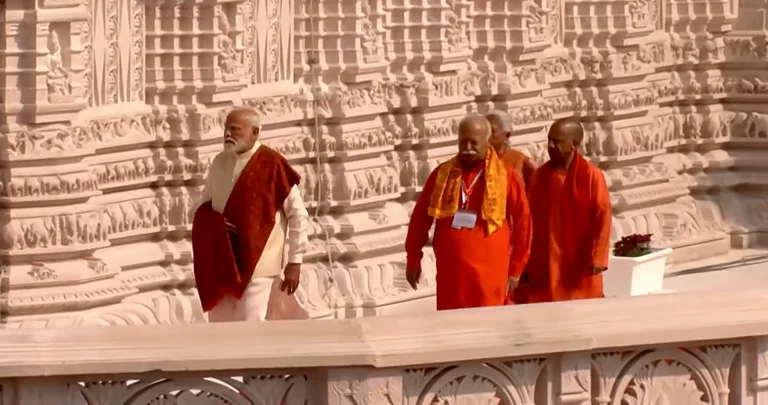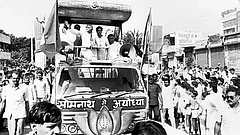All preparations for the Pran Pratistha ceremony of the idol of Shri Ram lalla (the child form of Lord Ram) are in full swing. The term Pran Pratistha refers to the sacred process of invoking divine consciousness into an idol through rituals and procedures prescribed in the ancient Vedic scriptures. Hindus believe that after performing the rituals of consecration, an idol is no longer an idol; it becomes a live form of the God, fully imbibing his consciousness and divinity. This is a momentous occasion for millions of devotees of Lord Ram who have been eagerly awaiting the Lord’s homecoming to Ayodhya, his birthplace. A sense of joy, excitement and happiness is palpable across the country.
The issue of Ram Mandir has occupied a pivotal position in the national discourse for years now. Now that the dispute is settled and the grand temple is nearing its completion, it is natural to ponder what this means for us, ordinary Indians. Is this just another temple in a country where, as such, there is no dearth of temples? Or is it much more than that? Honestly, these are questions where it’s almost impossible to present objective arguments. These are meant to be personal choices. But since I have keenly followed developments pertaining to the temple, I do have some perspectives. In my view, this entire journey to Ram Mandir gives an interesting insight on what India and Indians are made of—our values, virtues, beliefs and character.
Patience and faith in the divine: Patience and complete faith in the divine are ingrained as sacred virtues in Indian culture. In the Ramayana, the story of Shabari illustrates this beautifully. She had complete faith that one day she would get to serve Lord Ram himself. She waited patiently for years, tidying her ashram, anticipating the Lord’s arrival. Her prayers finally got answered when one day—en route to Lanka—Lord Ram visits her and showers his blessings by lovingly accepting berries half-eaten by her.
The story tells us that devotees who have complete faith in the divine must embrace patience to receive God’s blessings. A similar story seems to have unfolded with the Ram Mandir. The dispute in some sense started 500 years ago, around the late 1520s, during the reign of Babur, the first Mughal emperor. On this point, the Supreme Court, in its November 2019 verdict, notes: “This court is tasked with the resolution of a dispute whose origins are as old as the idea of India itself. The events associated with the dispute have spanned the Mughal empire, the colonial rule and the present constitutional regime.” More than the legal case, this is a story of patience with traits of ‘not knowing when’, but resolute faith and devotion towards Lord Ram.
Adherence to Dharma (rule of law): The quest for the Ram temple has been an emotive issue for Indians for years now. Hindus and Muslims have been at odds on this issue, in the courts and outside. There have been tragic incidences of violence. Nevertheless, the eventual resolution of this issue was always believed to happen through the course of law. Measures to resolve the dispute were taken within the confines of the Indian Constitution and the laws of the land. A constitutional bench of the Supreme Court finally reviewed the dispute in detail and pronounced a resolution in 2019, paving the way for the construction of the temple.
Developments after the apex Court verdict are remarkable. Both Hindus and Muslims accepted the court’s verdict with unmistakable grace.
Developments after the Supreme Court verdict are even more remarkable. Both Hindus and Muslims accepted the court’s verdict with unmistakable grace. It was extraordinary that the culmination of such a sensitive issue was devoid of instances of provocation or retaliation. People, who were standing at opposite ends in the court, reconciled and transitioned to implement the decision. This is a clear testimony to the fact that upholding dharma and adherence to the rule of law is part of the national character of India.
Devotion and service to the Lord: Offering selfless service has been an inherent way for Indians to express their devotion towards the supreme. Post the Supreme Court verdict, the Shri Ram Janmabhoomi Teerth Kshetra Trust was set up to facilitate the construction of a new grand Ram Temple at Ayodhya. The trust targeted collecting Rs 900 crore as donations from 11 crore devotees. The response to this call was so overwhelming that more than 18 crore devotees came forward contributing Rs 5,000 crore to the trust. Sufficient enough to fund the entire cost of the temple development through its interest alone!
The Bhagwad Gita offers an important perspective on this. Chapter 9, Verse 26 of the Gita states: “Patram puspam phalam toyam, yo me bhaktya prayacchati, tad ahambhakty-upahrtam, asnami prayatatmanah”. Here, Lord Krishna tells Arjun that with devotion if someone offers him even small objects such as a leaf, flower, fruit or water, he will accept it. What matters to God is the true feeling of devotion. So while capable devotees donated money, there are several examples where devotees expressed their joy by contributing in whatever way they could. Countless numbers of daily-wagers, rag pickers, street vendors and labourers donated as little as Rs 10 or Rs 20 to the trust. Some decided to walk hundreds of kilometres from their homes to get a glimpse of Lord Ram. Many are sending gifts such as sweets, utensils, foodgrains, rice and lamps. Saints are bringing water from holy rivers for the Lord. One devotee even sold his land and borrowed money from his relatives to donate to the trust. These services have been offered as true expressions of devotion and selfless service by devotees.
Modern India: One can also notice features of Modern India in the Ram Temple. It’s heartening to note that the government is leveraging the temple to modernise the entire Ayodhya region as well. It has plans to invest Rs 85,000 crore to create safe, convenient and quality infrastructure facilities for devotees and residents. Projects totalling Rs 31,000 crore are already underway. Lord Ram is also revered in some of the neighbouring countries such as Nepal, Sri Lanka and Thailand. People from Nepal are sending several gifts as offerings from the homeland of Mata Sita. Sri Lanka has gifted a rock from Ashok Vatika, believed to be the place where Ravana held Mata Sita captive. Thailand is sending soil and water from its rivers. These gestures are sure to boost the mutual goodwill and people-to-people connect between India and its neighbours, something that India is welcoming with open arms.
The Ram Temple is definitely a historic moment of celebration, inspiration and reflection. It’s a moment in history that shows that, as a country, we have faith in our institutions. That, in India, it’s possible to resolve more than a century-long emotionally rife dispute through the rule of law. At the same time, this should be the beginning of acknowledging some uncomfortable truths from our civilisational history with an intent to sincerely bring the process of lasting peace. Because the process of peace and reconciliation must start with acknowledging the truth, even if it’s uncomfortable or politically incorrect. Only then will things sustain in the long run. As the Ramayana says, “Aahuh satyam hi paramamdharmam dharmavido janaah”—those who have knowledge of dharma are aware that truth is the greatest dharma.
(Views expressed are personal)
MORE FROM THIS ISSUE
Kishore Desai is a public policy and infrastructure sector professional




























